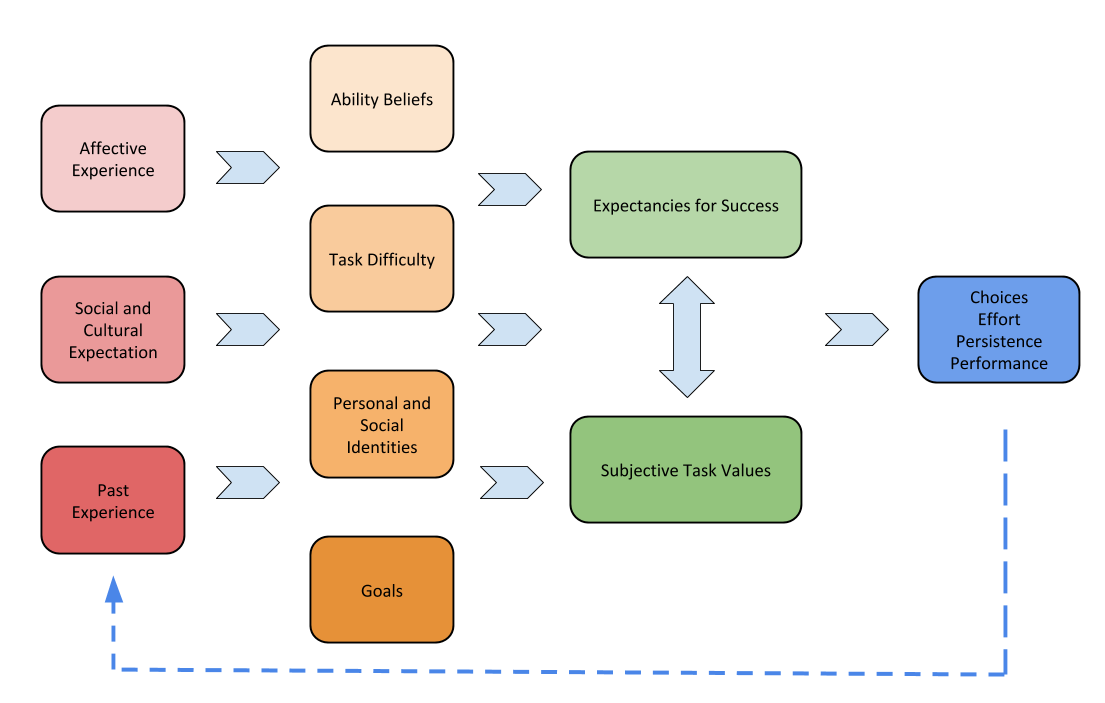Attribution Theory and Self-Efficacy Theory were examined in the previous articles in this Understanding Motivation in Games series. The current article will focus on Expectancy-Value Theory and how it applies in game research.
Expectancy-Value Theory
Expectancy-Value Theory of motivation (Wigfield & Eccles, 2000) is derived from Atkinson’s (1964) expectancy-value model, where individual’s ability beliefs, expectancies for success and subjective task values are crucial in determining individual’s choices, effort, persistence, and performance.
Ability beliefs are defined as individuals’ perception of current competence in a given domain. Expectancies for success are defined as individuals’ perception of success on future tasks. Expectancies for success and ability beliefs are distinct but highly related. Subjective task values are defined as value individuals place on tasks. Four components of subjective task values are defined, namely attainment value, intrinsic value, utility value and cost (Eccles et al., 1983). Attainment value refers to personal importance of performing well on tasks. Intrinsic value refers to amount of individual’s interest in the tasks or the enjoyment gains from performing the tasks. Utility value refers to the level of alignment between tasks and individual’s current and future goals. Finally, cost is identified as a crucial component in value (Eccles, 1987). Cost refers to opportunity and emotional cost for engaging in tasks, and the amount of effort required to succeed.
Expectancies for success and subjective task values are presumed to be influenced by task-specific beliefs such as ability beliefs, perceived task difficulty, personal and social identities, and individuals’ goals. Further, these task-specific beliefs are assumed to be influenced by individuals’ affective experience, perceptions of others’ expectations and attitudes and interpretation of past experience (Eccles & Wigfield, 2002). An overview of Expectacy-Value Theory is illustrated in Figure 1.

Figure 1. An overview of Expectancy-Value Theory.
Expectancy-Value Theory and Game Motivation Research
Expectancy-Value Theory has been applied in game research to examine different aspects of motivated behaviors, from adoption of games in the classrooms (Kenny & McDaniel, 2011; Sánchez-Mena, Martí-Parreño, & Aldás-Manzano, 2017), physical activity (Norris, Hamer, & Stamatakis, 2016; Zhang, Moore, Gu, Chu, & Gao, 2016), to learning (Chen, Zap, & Dede, 2013; Turkay, Hoffman, Kinzer, Chantes, & Vicari, 2014).
In a game research study by Livingston, Gutwin, Mandryk, and Birk (2014), the values of game characters (or called avatars) in World of Warcraft among twenty experienced players. The study was conducted using qualitative research methods, including observations (of play sessions) and interviews. Ten types of value were identified and summarized in Table 1.

Table 1. Ten character values identified by WoW players.
Results indicated that players ascribed to game characters in a number of ways and perspectives, and values played a vital part in determining player’s actions, experience, and motivation. The authors suggested four recommendations for enhancing player’s motivation through providing opportunities for players to develop and build value-relationships with characters. First, games can enhance support for aesthetic and creative value by providing additional capabilities for designing, creating, and purchasing clothing and apparel items for game characters. Second, games can enhance communication features to facilitate social interactions to promote social value. Third, games can support investment value by expanding character attributes and providing more opportunities for players to improve their characters. Finally, games can provide players with ability to record or revisit previous experience to facilitate memory value.
In sum, Expectancy-Value Theory allows game researchers and designers to understand how different social, cognitive and affective factors influence player’s perceived ability, expectancy for success and values, which in turn, influence their behaviors and motivation to play.
References
Atkinson, J.W. (1964). An Introduction to Motivation. Princeton, NJ: Van Nostrand.
Chen, J. A., Zap, N., & Dede, C. (2013). Using virtual environments to motivate students to pursue STEM careers: An expectancy-value model. In Immersive environments, augmented realities, and virtual worlds: Assessing future trends in education (pp. 42-56). IGI Global.
Eccles, J. S. (1987). Gender roles and women’s achievement‐related decisions. Psychology of women Quarterly, 11(2), 135-172.
Eccles J. S., Adler, T. F., Futterman, R., Goff, S. B., Kaczala, C. M., Meece, J. L., &Midgley, C. (1983). Expectancies, values, and academic behaviors. In J. T. Spence (Ed.), Achievement and achievement motivation (pp. 75–146). San Francisco, CA: W. H. Freeman.
Eccles, J. S., & Wigfield, A. (2002). Motivational beliefs, values, and goals. Annual review of psychology, 53(1), 109-132.
Kenny, R. F., & McDaniel, R. (2011). The role teachers’ expectations and value assessments of video games play in their adopting and integrating them into their classrooms. British Journal of Educational Technology, 42(2), 197-213.
Livingston, I. J., Gutwin, C., Mandryk, R. L., & Birk, M. (2014, February). How players value their characters in world of warcraft. In Proceedings of the 17th ACM conference on Computer supported cooperative work & social computing (pp. 1333-1343).
Norris, E., Hamer, M., & Stamatakis, E. (2016). Active video games in schools and effects on physical activity and health: a systematic review. The Journal of pediatrics, 172, 40-46.
Sánchez-Mena, A., Martí-Parreño, J., & Aldás-Manzano, J. (2017). The role of perceived relevance and attention in teachers’ attitude and intention to use educational video games. International Journal of Emerging Technologies in Learning (iJET), 12(03), 154-168.
Turkay, S., Hoffman, D., Kinzer, C. K., Chantes, P., & Vicari, C. (2014). Toward understanding the potential of games for learning: Learning theory, game design characteristics, and situating video games in classrooms. Computers in the Schools, 31(1-2), 2-22.
Wigfield, A., & Eccles, J. S. (2000). Expectancy–value theory of achievement motivation. Contemporary educational psychology, 25(1), 68-81.
Zhang, T., Moore, W., Gu, X., Chu, T. L., & Gao, Z. (2016). Promoting Children’s Physical Activity in Physical Education: The Role of Active Video Gaming. JTRM in Kinesiology.
